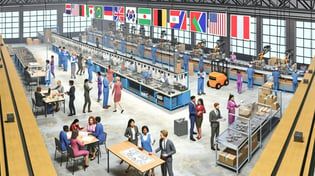Outsourcing vs. Insourcing
In the complex realm of industrial manufacturing, plant managers constantly face the pivotal decision between outsourcing and insourcing various aspects of their operations. This decision carries significant implications for the efficiency, cost-effectiveness, and overall success of the manufacturing facility. As the leader tasked with steering the ship, understanding the nuances of this choice is paramount.
In this blog, we'll look into the key factors to consider when weighing the pros and cons of outsourcing versus insourcing, with a particular focus on how integrating advanced planning and scheduling solutions like PlanetTogether with ERP, SCM, and MES systems can streamline operations regardless of the chosen path.
Outsourcing and Insourcing
Outsourcing involves contracting third-party vendors to handle specific tasks or processes that would otherwise be performed in-house. On the other hand, insourcing entails keeping all operations within the company's own facilities and workforce.

The Outsourcing Advantage
Outsourcing offers several potential benefits for manufacturing facilities:
Cost Savings: Outsourcing certain tasks can often lead to significant cost reductions, particularly when considering labor, equipment, and overhead expenses. Third-party vendors may have specialized expertise and economies of scale that translate into lower costs for the manufacturer.
Focus on Core Competencies: By outsourcing non-core activities, plant managers can concentrate their resources and attention on the core competencies that drive the company's competitive advantage. This focus can foster innovation, efficiency, and overall business growth.
Flexibility and Scalability: Outsourcing provides flexibility in scaling production capacity up or down in response to fluctuating market demands. Third-party vendors can quickly adjust resources to meet changing requirements, mitigating the risks associated with overcapacity or underutilization of assets.

Leveraging PlanetTogether in Outsourcing Scenarios
Consider a manufacturing facility that outsources the production of certain components to external suppliers. By integrating PlanetTogether with the facility's ERP and SCM systems, the plant manager can achieve the following:
- Gain visibility into the availability and lead times of outsourced components, allowing for accurate scheduling of production runs to minimize idle time and inventory holding costs.
- Automatically generate purchase orders and production schedules based on forecasted demand, taking into account supplier constraints and delivery schedules.
- Utilize "what-if" scenario analysis to assess the impact of outsourcing decisions on overall production efficiency, cost, and customer satisfaction.
- Implement predictive analytics to anticipate potential bottlenecks or supply chain disruptions, enabling proactive mitigation strategies to minimize their impact on operations.

The Insourcing Imperative
While outsourcing offers compelling advantages, insourcing also presents its own set of benefits that should not be overlooked:
Quality Control: Keeping operations in-house provides greater control over the entire production process, from raw material sourcing to final product assembly. This control allows for tighter quality standards and faster resolution of any issues that may arise, safeguarding the company's reputation and customer satisfaction.
Intellectual Property Protection: Insourcing can mitigate the risks associated with sharing proprietary information and trade secrets with external vendors. By keeping critical processes within the company's own facilities, plant managers can protect valuable intellectual property and maintain a competitive edge in the market.
Agility and Responsiveness: Insourcing enhances the manufacturing facility's agility and responsiveness to changing market dynamics and customer preferences. With all operations under one roof, plant managers can quickly adapt production schedules, introduce product innovations, and respond to customer feedback without relying on external partners.

Leveraging PlanetTogether in Insourcing Scenarios
Integrating PlanetTogether with ERP, SCM, and MES systems is equally beneficial in insourcing scenarios, empowering plant managers to:
- Optimize resource utilization and minimize idle time through advanced production scheduling algorithms that consider machine capacities, labor availability, and production workflows.
- Streamline inventory management by synchronizing production plans with material requirements planning (MRP) systems to ensure adequate stock levels without excessive holding costs.
- Enhance workforce productivity by aligning production schedules with labor schedules, skill sets, and training requirements, optimizing employee efficiency and satisfaction.
- Improve overall equipment effectiveness (OEE) by identifying and addressing inefficiencies in production processes, such as equipment downtime, setup times, and changeover procedures.


Integrating PlanetTogether with ERP, SCM, and MES Systems
One of the critical aspects of successful outsourcing lies in effective planning and coordination between the manufacturing facility and external vendors. Here, the integration of advanced planning and scheduling (APS) software such as PlanetTogether with ERP, SCM, and MES systems plays a pivotal role.
PlanetTogether's APS capabilities enable plant managers to:
- Seamlessly synchronize production schedules with procurement, inventory, and supply chain management systems to ensure timely delivery of materials from external suppliers.
- Optimize production plans by considering lead times, capacity constraints, and resource availability both within the facility and among outsourcing partners.
- Monitor and track progress across the entire manufacturing ecosystem, from raw material procurement to final product delivery, ensuring alignment with quality standards and customer expectations.
- Facilitate real-time communication and collaboration between the manufacturing facility and external vendors, enabling quick adjustments to production schedules in response to unforeseen disruptions or changing market conditions.
In the landscape of industrial manufacturing, the decision between outsourcing and insourcing is a complex balancing act that requires careful consideration of various factors, including cost, quality, flexibility, and strategic alignment. Regardless of the chosen approach, integrating advanced planning and scheduling solutions like PlanetTogether with ERP, SCM, and MES systems can empower plant managers to optimize operations, mitigate risks, and drive sustainable growth.
By leveraging the capabilities of these integrated systems, manufacturing facilities can navigate the outsourcing versus insourcing dilemma with confidence, positioning themselves for success in an increasingly competitive marketplace.
Are you ready to take your manufacturing operations to the next level? Contact us today to learn more about how PlanetTogether can help you achieve your goals and drive success in your industry.



